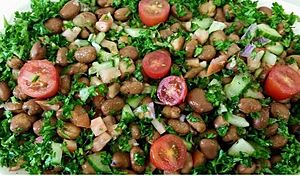Ful medames facts for kids

Ful served with hummus dip
|
|
| Alternative names | Fūl |
|---|---|
| Course | Breakfast, main course |
| Place of origin | Egypt |
| Main ingredients | Fava beans, vegetable oil, cumin |
| Variations | Lemon juice, onion, parsley, garlic |
Ful medames (Arabic: فول مدمس, fūl mudammas), or simply fūl, is a yummy stew made from cooked fava beans. It's usually served with olive oil and a spice called cumin. Sometimes, people add chopped parsley, garlic, onion, lemon juice, or chili peppers to make it even tastier!
Ful medames is traditionally cooked and served from a big metal pot. It's a super important food in Egypt and is even considered their national dish. This is especially true in cities like Cairo and Gizah. You can also find fava beans cooked in different ways in other parts of the Middle East and Africa.
Contents
History of Ful
Some people believe that ful medames has been around since the time of Ancient Egypt. This makes it a very old dish!
Archaeologists found 2,600 dried fava beans at an old site near Nazareth. This shows that fava beans were used a long, long time ago. The way ful is cooked today is even mentioned in an old book called the Jerusalem Talmud. This means people in Africa and the Middle East have been cooking fava beans this way since the fourth century.
Even though there are many ways to enjoy fūl, the basic recipe stays the same. Once the fūl is cooked, it's salted. Then, it can be eaten plain or with different toppings. These toppings can include vegetable oil, butter, eggs, tomato sauce, garlic sauce, tahini, fresh lemon juice, or chili peppers.
Cooking Ful in Old Cairo
In the Middle Ages, there was a special place in Cairo where most of the city's fūl was made. This place was near the Princess Baths, which were public bathhouses.
The people who worked at the baths would light big fires to heat the bath water. They used wood, but wood was hard to find, so they often used garbage as fuel. After the baths closed for the day, the fires would still have hot embers. To use this heat, huge pots called qidras were filled with fava beans. These pots would simmer all night and even all day. This way, they could provide breakfast for everyone in Cairo! Cookshops from all over the city would send their workers to the Princess Baths to buy fūl in large amounts.
Types of Fava Beans
In Egypt, different kinds of fava beans are used to make fūl.
- Fūl ḥammām are small, round beans. These are often used for traditional fūl.
- Fūl rūmī are larger, kidney-shaped fava beans.
- Fūl baladī are medium-sized "country beans."
- Fūl nābit are fava bean sprouts.
- Fūl akhḍar means "green fūl," which are fresh fava beans.
- Fūl madshūsh are crushed fava beans.
Ful in Other Countries

Ful medames spread from Egypt to many other parts of the Arab world, Africa, and Asia. It's especially popular in countries like Iraq, Lebanon, Syria, Jordan, Saudi Arabia, Yemen, Somalia, Ethiopia, Sudan, and Morocco.
Middle East
Ful is a popular breakfast dish in Syria, especially in Aleppo. The fava beans are cooked slowly in large copper pots overnight. In the morning, they are served with tahini (sesame paste) and olive oil. Sometimes, a hint of red pepper paste is added on top.
In Jordan, ful is often made like a dip, similar to hummus. It usually includes tahini, garlic, tomato, lemon juice, ground cumin, olive oil, green peppers, and salt.
Many Christian communities in Arab countries eat ful medames as part of their diet during Lent.
Africa
In Somalia, fuul is a common breakfast food. It's often served with eggs, khubz bread, or a traditional Somali flatbread called laxoox. Somali fuul is similar to the Egyptian and Sudanese versions, but it's usually spicier. This is because Somalis use a special spice mix called xawaash.
In Morocco, ful is known as bissara. It's made from fava beans and split green peas cooked with garlic. It's served with cumin and other seasonings. Bissara is very popular in northern Morocco and is often eaten during the cold winter months.
In Ethiopia (and Eritrea), ful is one of the few dishes not eaten with injera, which is a pancake-like bread. Instead, it's served with wheat flour bread. Places that serve ful often have a shared kitchen where people can bake this type of bread. The beans are topped or mixed with oil and a spice blend called berbere.
Other Regions
In Malta, ful bit-tewm (beans with garlic) is often eaten during Lent and Good Friday. The beans are soaked overnight, then cooked in oil with garlic and fresh or dried mint. Before serving, they are dressed with olive oil or vinegar.
The dish has also traveled as far as Malaysia, especially the state of Johore, and Singapore. There, it has been changed into a local recipe called kacang pool. This version uses ghee instead of oil and often includes minced meat. Kidney beans and baked beans are sometimes added to make the dish heartier.
Ful Medames Salad
Ful medames salad (Arabic: سلطة فول مدمس) is a favorite Arab breakfast side dish, or mezze. It can also be eaten as a filling salad. It usually has fava beans, chopped tomatoes, onion, parsley, lemon juice, olive oil, pepper, and salt.
See also
 In Spanish: Ful mudammas para niños
In Spanish: Ful mudammas para niños


